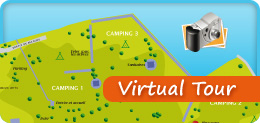ERDEVEN
“The country on the coast.”
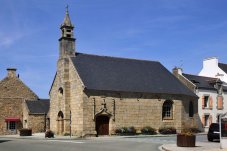 Situated between the Etel River and the Gulf of Morbihan, between the country and the sea, Erdeven has a rich prehistoric and historic heritage : rows of standing stones (menhirs and dolmens), castles, manor houses and chapels with fountains. Signs along the walking paths will help you to discover these charming sites.
At Point Erdeven, after bathing the coasts of of Kerhilio and Kerminihy, the sea enters the magnificent Etel river valley. Erdeven has 300 hectares of protected unspoilt dunes with a fringe of fine golden sand stretching 8kn along the coast. It also is a special megalithic site, with rows of menhirs and dolmens amongst the pines, gorse, broom, flowering euphorbia and asphodel. The ocean offers its own maritime pleasures: from simple swimming to diving, sailing, windsurfing...
Situated between the Etel River and the Gulf of Morbihan, between the country and the sea, Erdeven has a rich prehistoric and historic heritage : rows of standing stones (menhirs and dolmens), castles, manor houses and chapels with fountains. Signs along the walking paths will help you to discover these charming sites.
At Point Erdeven, after bathing the coasts of of Kerhilio and Kerminihy, the sea enters the magnificent Etel river valley. Erdeven has 300 hectares of protected unspoilt dunes with a fringe of fine golden sand stretching 8kn along the coast. It also is a special megalithic site, with rows of menhirs and dolmens amongst the pines, gorse, broom, flowering euphorbia and asphodel. The ocean offers its own maritime pleasures: from simple swimming to diving, sailing, windsurfing...
ETEL RIA
«The Etel River flows into the Morbihan, forming a little bay dotted with islets.»
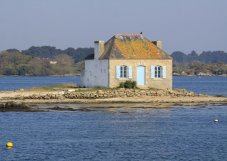 This area is well-known for its ecosystem, which shelters remarkable flora and fauna. From the bar to the head of the river, the Etel valley is an enchanting mixture: beaches of fine sand, hidden creeks with the remains of tuna fishing boats which once brought wealth to this corner of southern Brittany, seabird sanctuary islets, mysterious forests, and oyster farms providing marine delicacies.
It is a delight to discover this most secret of the little inland seas in any season. For keen sailors or canoeists the river estuary offers a large area opening out to the sea. For those who prefer the beach, the dunes show the way. Signed paths offer walks to discover shrines and chapels, which feature in lovely local legends.
This area is well-known for its ecosystem, which shelters remarkable flora and fauna. From the bar to the head of the river, the Etel valley is an enchanting mixture: beaches of fine sand, hidden creeks with the remains of tuna fishing boats which once brought wealth to this corner of southern Brittany, seabird sanctuary islets, mysterious forests, and oyster farms providing marine delicacies.
It is a delight to discover this most secret of the little inland seas in any season. For keen sailors or canoeists the river estuary offers a large area opening out to the sea. For those who prefer the beach, the dunes show the way. Signed paths offer walks to discover shrines and chapels, which feature in lovely local legends.
CARNAC
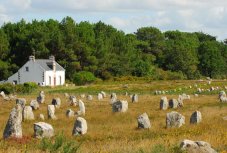 Carnac is the essence of southern Brittany, a fashionable coastal resort, well-known for its beaches of fine sand and fields of standing stones.
Carnac is the essence of southern Brittany, a fashionable coastal resort, well-known for its beaches of fine sand and fields of standing stones.
Quiberon
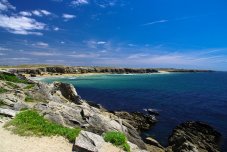 S’Stretching 14km into the sea, the Quiberon Peninsular offers spectacular scenery: to the west, a wild coast with rugged cliffs, while to the east, a series of beaches with fine sand look over the bay. The peninsular, made up of the two districts of Quiberon and St Pierre Quiberon, also provides many enjoyable walking tracks. http://www.quiberon.com/
S’Stretching 14km into the sea, the Quiberon Peninsular offers spectacular scenery: to the west, a wild coast with rugged cliffs, while to the east, a series of beaches with fine sand look over the bay. The peninsular, made up of the two districts of Quiberon and St Pierre Quiberon, also provides many enjoyable walking tracks. http://www.quiberon.com/
Golfe du morbihan
«The Little Sea and its treasures»
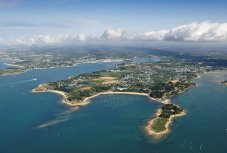 If the sight of 150,000 brightly coloured birds, the beauty of uncountable islands, festivals, music and friendly smiles don’t move you … then the Gulf of Morbihan is not for you ! For the others, we can only say “Welcome to paradise !”
If the sight of 150,000 brightly coloured birds, the beauty of uncountable islands, festivals, music and friendly smiles don’t move you … then the Gulf of Morbihan is not for you ! For the others, we can only say “Welcome to paradise !”
Do sea views charm you ? Enjoy the simple natural pleasure of walking on the kilometres of coastal tracks through the protected landscapes around the “Little Sea”. The island of Berder, near Larmor-Baden, offers a unique experience. Accessible at low tide, the rising tide can trap the unwary on the island, to the amusement of better-informed passers-by. Are you interested in history with a capital “H” ? You can literally touch it: cairns and megaliths at Arzon and Locmariaquer, mediaeval cities in the hinterland, the Suscinio Castle of the Dukes of Brittany at Sarzeau... The treasures of the Gulf don’t reveal themselves all at once … it will take a lifetime!
Vannes
«Discover Vannes , the port of the Gulf of Morbihan, at the centre of the western region. Vannes is a magical place, where the sea, the land and the sky offer a unique and ever-changing landscape.»
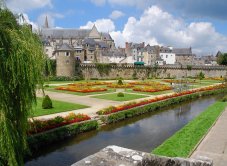 Historic and modern at the same time, Vannes charms you with its ramparts and mediaeval centre, as well as its university and businesses oriented towards the future. This rich and varied environment deserves to be promoted and preserved.
Historic and modern at the same time, Vannes charms you with its ramparts and mediaeval centre, as well as its university and businesses oriented towards the future. This rich and varied environment deserves to be promoted and preserved.
Auray et son port
«nestled in a river valley in the Gulf of Morbihan»
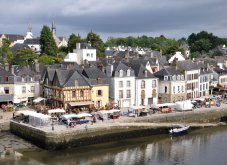 A free ‘Browse through Auray’ guide is available from the tourist office. This pretty town is situated in a river valley in the Gulf of Morbihan, sheltered from the winds, where the river and sea meet.
In the Middle Ages, the Dukes of Brittany built a bridge, a port and a castle, resulting in a town with two parts: the port, at the foot of the fortress, and the upper town, above the port. Although the fortress disappeared in the 16th century, the half-timbered houses and the stone buildings are clear evidence of the historic wealth of the town.
Historically a trading port, St. Goustan is now a centre for leisure sailing, browsing and walking. Its unique historic atmosphere and shimmering colours are also an inspiration for artists. Over the past centuries, the traditional heart of the town has hardly changed. Auray has preserved the charm of historic towns, with its narrow paved lanes and half-timbered houses.
The large market on Monday mornings has been one of the main meeting places for centuries. Discover Auray by taking the heritage walks.
A free ‘Browse through Auray’ guide is available from the tourist office. This pretty town is situated in a river valley in the Gulf of Morbihan, sheltered from the winds, where the river and sea meet.
In the Middle Ages, the Dukes of Brittany built a bridge, a port and a castle, resulting in a town with two parts: the port, at the foot of the fortress, and the upper town, above the port. Although the fortress disappeared in the 16th century, the half-timbered houses and the stone buildings are clear evidence of the historic wealth of the town.
Historically a trading port, St. Goustan is now a centre for leisure sailing, browsing and walking. Its unique historic atmosphere and shimmering colours are also an inspiration for artists. Over the past centuries, the traditional heart of the town has hardly changed. Auray has preserved the charm of historic towns, with its narrow paved lanes and half-timbered houses.
The large market on Monday mornings has been one of the main meeting places for centuries. Discover Auray by taking the heritage walks.
Les Iles «Belle-île, Houat, Hoëdic, Groix»
“Continent ne puis, Presqu’île ne daigne, Belle-Ile suis” (Henri QUEFFELEC)
Belle-Île-en-Mer
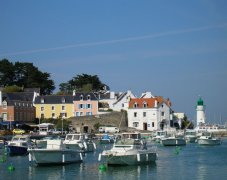 The island lives up to the promise of its name : ‘Beautiful Island in the Sea’. It is the largest of the western islands and one of the highest, rising up to 71m above sea level. Belle-Ile offers a contrasting palette of landscapes: natural harbours and deep river valleys, hidden creeks of turquoise water, vast beaches of fine golden sand, rugged cliffs with sea grottos. Inland, there are little villages of low white houses, wooded valleys scented with wild mint …
The island lives up to the promise of its name : ‘Beautiful Island in the Sea’. It is the largest of the western islands and one of the highest, rising up to 71m above sea level. Belle-Ile offers a contrasting palette of landscapes: natural harbours and deep river valleys, hidden creeks of turquoise water, vast beaches of fine golden sand, rugged cliffs with sea grottos. Inland, there are little villages of low white houses, wooded valleys scented with wild mint …
This dream area is divided into four districts: Le Palais, the ‘capital’, guarded by its impressive citadel Sauzon, a charming little port in pastel colours Bango and its tall lighthouse Goulphar, which dominates the wild coast Locmaria, the most rural, with the village huddled around a little church full of legends
Throughout the year, the districts of Belle-Ile are enlivened by exhibitions, concerts, shows and festivale.







